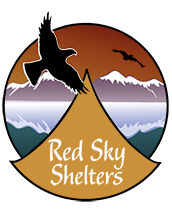What is PVC, and what’s wrong with it?
Red Sky Shelters is committed to offering materials that yield the best performance, durability and safety with the least environmental impact. Close to a decade ago we phased out the use of PVC-coated fabrics for our Yome coverings. This decision left us with very few options and we have had to pioneer and develop our own alternative materials. From our silicone Legacy roof fabric to our new Frontier 100% hemp sidewall fabric, we have developed a set of fabric options that are suitably durable and functional yet environmentally friendly.
What is PVC, and what’s wrong with it?
PVC stands for polyvinyl chloride, commonly known as vinyl. It is one of the most commonly used plastics in the world. Unfortunately, it’s also one of the worst products for the environment. Every step in the life cycle of PVC is riddled with serious environmental and health concerns. This is why Red Sky Shelters, unlike nearly every other portable shelter manufacturer, has eliminated the use of PVC-coated fabric in its products.
When PVC is produced, many of its basic constituents (including ethylene dichloride and vinyl chloride) are released into the atmosphere. These are considered to be not only carcinogenic but also to cause liver, kidney and neurological damage. Workers in vinyl plants have become ill from exposure to these toxic compounds.
PVC manufacturing plants also create significant amounts of dioxins and PCBs, and these frequently leach into the groundwater. In fact, sediment samples taken downstream from these plants have shown dioxin concentrations equal to that of Agent Orange! See PVC Bad News in Threes and Polyvinyl Chloride.
Learn More about PVC
Even more problems are created when PVC is used as a fabric coating. This is because PVC is normally a rigid substance. In order to make it flexible, plasticizers are added. Over time, these plasticizers leach to the surface and are released into the air. This is the off-gassing commonly recognized as the “vinyl odor” in shower curtains and children’s toys. Studies indicate that there are health concerns associated with these plasticizers as well. See Our Stolen Future.
It is possible to add a final coat to PVC-coated fabrics, sealing in the plasticizers. This is often done on exterior surfaces for added durability and cleanability. However, the interior surface is typically lacks this top coating, forcing the plasticizers to off-gas into the interior. This is a significant problem in living spaces. Sealing the interior surface helps, but this only addresses one of the many health and environmental problems associated with PVC.
Claims are made that PVC coated fabric can be recycled. However, trying to recycle it causes even more problems and requires more energy than what it would take to landfill it and make more from scratch. Should it be incinerated or burned, PVC releases several extremely toxic substances including dioxin.
Despite these drawbacks, other yurt and dome manufacturers use vinyl-coated fabric almost exclusively. And not only is the roof PVC: Though few manufacturers will call attention to it, the sidewalls are PVC-coated as well. Yurts and domes are considered “alternative” living structures, yet they are completely coated in one of the most ubiquitous and environmentally-destructive substances known. Note that when other manufactures call their fabric “resin-finished” or “acrylic top-coated,” they’re not admitting that these are only the top-coats and most of the material is PVC.
From production to consumption to disposal, vinyl raises serious health and environmental concerns. You can count on Red Sky Shelters to be aware of these concerns and always choose the best materials for your health and that of the planet.

Leave a Reply
Want to join the discussion?Feel free to contribute!